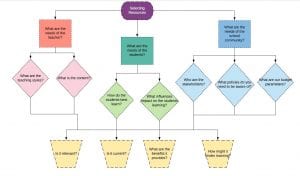Word Count: 750
The digital story-telling project is designed to engage students’ interest and display an example of how students can interpret their own creations. Originally the task was for students to redesign a sustainability text and critique the text on the important topic of Sustainability, however, after discussions of originality and copyright were presented, the texts then became an inspiration, rather than a digital copy. The audience for this story is the students of 5/6Gold to present their assessment challenge and create a unique exploration of Bowen Public School.
The story is presented as an adventure through Bowen Public School and students are presented with areas of sustainability and the impact the school community has on the environment. The subject areas of Science, through the exploration of human impact on the environment (NESA, 2015), and English remain at the forefront and the importance of sustainability and Aboriginal and Torres Strait Islander Histories and Cultures (ATSIHC) remain prevalent and develop ICT capabilities as a cross-curricula priorities (ACARA, 2016). The purpose of the story is to formulate questions and ideas about ATSIHC and Sustainability present in Bowen Public School and encourage students to focus on the area that is most relevant to their individual lives (University of Houston, 2013). Students will then be grouped based on their interests and continue the project by creating their own digital story on their chosen topic within Bowen Public School and/or their local community.
Bowen Public School has a substantial amount of opportunities for students to participate in ATSIHC through NAIDOC, BroSpeak and SisterSpeak as well as in the classroom. The project allows students to focus on the areas that they need to address in their learning and feel comfortable presenting. Bowen Public School has a 50% Indigenous population. By providing the option students who are non-Indigenous can learn more about the Indigenous culture and Indigenous learners can either highlight their culture or learn about Sustainability. Sustainability is not currently a large priority for the school and this project is designed to promote an interest and understanding of Sustainability and how it could be further developed within Bowen Public School.
Multimodal texts as an area of study has been planned for Term 4 and the project is creating a space for students to explore how texts work in a digital format, how to shape their own digital stories and decide on their audience (NESA,2015), whether that be to the class, teachers or school community as a whole as well as exploring relevant and real life topics (Tackvic, 2012). Students are provided with guidance to support the various learning needs through different texts as examples of ATSIHC and Sustainability and the deconstruction of the story used as an example. Students are given guidance and support in constructing the storyboards and plans, as well as how to incorporate either video footage or photographs shot on iPads, iPhones or the professional cameras provided by the school. Each student has a Chromebook with Windows Movie Maker and explicit step by step lessons establish how the ‘hook’ story was designed enables students to edit their own digital stories.
The value of a digital storytelling product is through reading, sharing, creating and analyzing (Serafini & Young, 2013). The project requires students to read and understand texts on a deeper level to ensure that they are presenting the information correctly and accurately. They develop their reading and writing skills through the project and synthesise their ideas to ensure it fits within the 3-5 minute timeframe. Sharing is presented through the development and creation of their video to share on an online community and converse with the larger school community about topics that they are interested and engaging with. The creation of their video is a source of quality understand and assessment and provide students with a tangible product to admire and continue to reflect on. The creating process requires high-order thinking skills to be activated and students will need to have the confidence in their final product. Finally students need to critically analyse their final works and the other members of the class to reflect on their learning and experiences to help solidify learning and to inform further teaching activities.
This digital storytelling product requires students to be able to work in a group environment alongside having access to the recording devices and Chromebooks. Students need to receive a USB to ensure that students consistently have access to their product. Consideration to the length of the video, the language used and the supports students need.
References
Australian Curriculum, Assessment and Reporting Authority. (2016). Cross-Curriculum Priorities. Retrieved from https://www.acara.edu.au/curriculum/cross-curriculum-priorities
NSW Education Standards Authority. (2015). English K-10 Syllabus: NSW Syllabus for the Australia Curriculum. Teaching & Educational Standards, Sydney NSW.
NSW Education Standards Authority. (2015). Science K-10 Syllabus: NSW Syllabus for the Australia Curriculum. Teaching & Educational Standards, Sydney NSW.
Serafini, F., & Youngs, S. (2013) Reading Workshop 2.0. Reading Teacher. 66(5), 401-404. https://org.ezproxy.csu.edu.au/10.1002/TRTR.01141.
Tackvic, C. (2012). Digital storytelling: Using technology to spark creativity. The Educational Forum, 76(4), 426.
University of Houston (2013). Educational uses of digital storytelling: What is digital storytelling? Retrieved from http://digitalstorytelling.coe.uh.edu/page.cfm?id=27&cid=27


